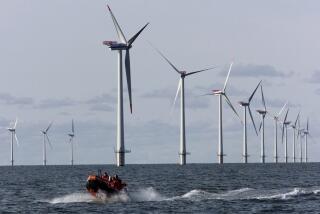Nukes still work when the sun doesn’t shine and the wind doesn’t blow
- Share via
Wind turbines, solar energy collectors and photovoltaic cells have been popular sources of electricity since the oil crisis in the late 1970s, and they are increasingly favored by many scientists and much of the public as methods for reducing global warming. But the latest results from 2006 give the discouraging news that wind energy generated less than 1% of the electricity needs in the United States and 2% of California’s electricity. Solar energy generates less than 0.1% and 0.2%, respectively.
A Los Angeles Times’ September 17 editorial suggested several reasons for the failure of wind energy to compete for the generation of electricity in California. The older wind farms in the San Gorgonio Pass, the Tehachapi and Solano County are outdated. New wind turbines have not followed, primarily because of competition from lower-cost natural gas. Narrow interest groups homeowners protecting their scenic views and environmentalists guarding wildernesses and birds among them oppose new projects. And expensive electrical power lines are required to connect the remote wind turbines to population centers. The Times urges increased federal and state subsidies for the wind and solar industries.
While the above arguments are valid, the primary reason that wind and solar energies have not made inroads in the past, and will never supply more than a few percentage points of the world’s electrical energy, is their unpredictable variations in time and their constant need for back-ups. They only generate energy when the wind blows and the sun shines. We are so dependent on electricity for work and recreation that we don’t permit even occasional outages of a few minutes. Perfect weather predictions are impossible, and no successful method has been discovered to store the electrical energy for the hours, days or weeks required. At the best sites, the wind blows only about 40% of the time. Because the wind times are not predictable, the wind turbines must be backed up 60% of the time, with dependable generators available 100% of the time. Because of the Earth’s rotation and latitude effects, the solar back-up energy must be constantly changed. The only non-carbon-dioxide-emitting generator capable of backing up wind and solar energy and replacing coal and gas generators is nuclear fission.
The Times cites a Department of Energy claim that an area in Nevada equipped with solar devices could meet the power needs of the entire United States. Consider how large this area would have to be. The total U.S. yearly generation of electrical energy is the equivalent of about 450 large coal, gas or nuclear reactor electrical plants of 1,000 megawatts each, running continuously for one year. To calculate the area of photovoltaic detectors required to furnish the same energy as one large plant of 1,000 megawatts, we select a location near Phoenix, Ariz., at latitude 33.4 degrees north. A horizontal surface there collects on average about one-fifth that of the solar constant the energy from the sun per-second per-unit-area arriving above the Earth’s atmosphere. This average takes into account the absorption by the Earth’s atmosphere, day-night differences, latitude, clouds and storms averaged over one year. The efficiency of commercial cells is about 20%. The area of cells equivalent to one 1,000-megawatt plant would be about 10 square miles. To find the total area of cells that would furnish all the electricity generated in the United States, multiply by the 450 electrical plants and get 4,500 square miles.
This area of the cells needed about the size of the state of Connecticut is not trivial. Nuclear power may be the practical solution to global warming, after all.
R. Stephen White is an emeritus professor of physics at UC Riverside and author of the book “Energy for the Public: The Case for Increased Nuclear Fission Energy.” Click to read more about The Times’ Blowback feature.
More to Read
A cure for the common opinion
Get thought-provoking perspectives with our weekly newsletter.
You may occasionally receive promotional content from the Los Angeles Times.






